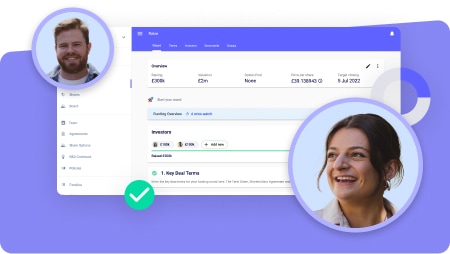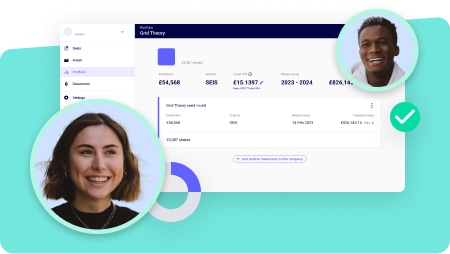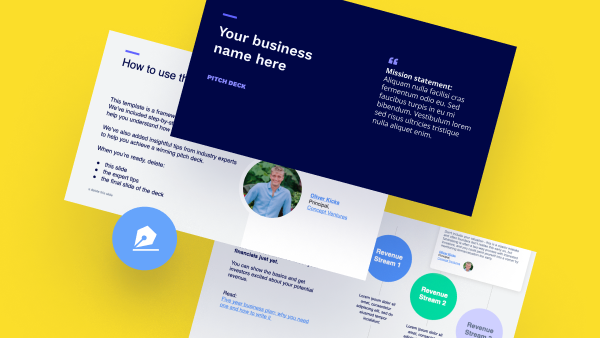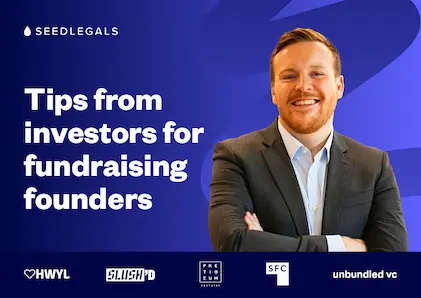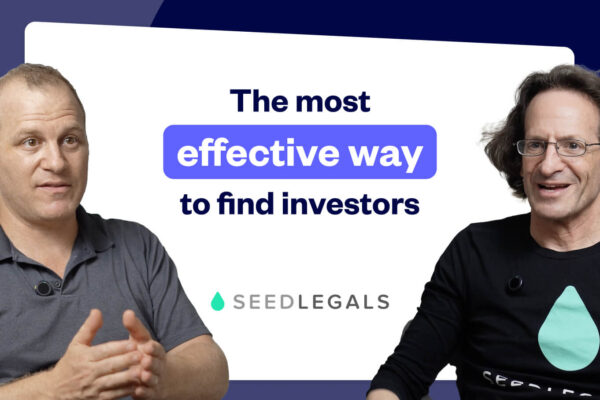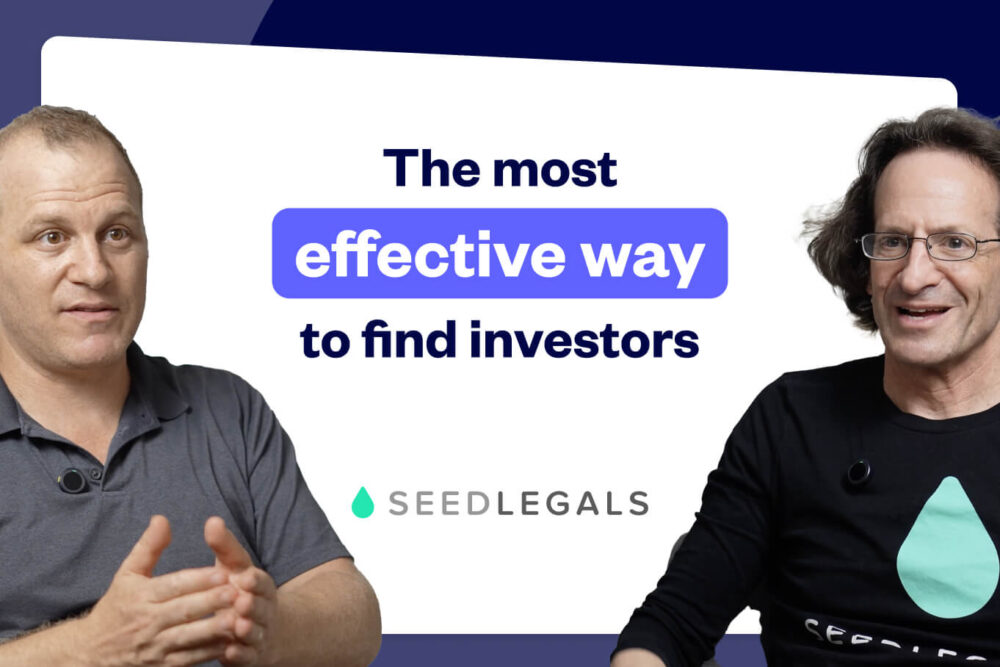Read transcript
Anthony: One of the things I get asked all the time at SeedLegals is, how do I find investors? If you go online, you’ll get useless words of wisdom, like, get a warm intro. Well, it’s like, how are you going to get a warm intro? It’s fine if you happen to be well connected with Index Ventures, but if you’re not, where’d you go? So we were chatting, Dori and I, and I loved your advice. So Dori, tell me about your background and then we’re going to help founders work out how to find investors online. Dori, over to you.
Dori: Thank you for that. I’m Dori. I’m on my fourth startup now. I exited my first, I’ve raised over 50 million in my career, and now I help startups, raise funds either by helping them apply for, to innovate UK or, approaching investors, be it angels or VCs. And I love your question and the way you frame the subject, because I see so many people in the industry giving great advice about how to craft your deck, about how to craft your elevator pitch, about what to say or not to say with investors.
And it’s all great. The only problem is if you’ve got the most amazing deck and no one sees it, it’s useless. And that’s what I see time and time again, people creating spectacular deck designs. They’re paying hundreds of dollars for design. They’re paying thousands of pounds for the content, for consultants, and then they hire a banker, or they use mass outreach, sending thousands of investors emails. It just drives me bonkers. It’s called Spray and Pray. Spray and pray people with mass outreach, then get very disappointed that you’ve reached out to 300 people and zero have responded.
The problem is that I wrote the same email to everyone saying, we are fundraising, here’s my deck, we are unique, Nobody responded.
So let’s go through some of the common pitfalls and then we will talk about the techniques people can use to raise. And of course, it’s going to be different depending on the stage of your business, right? If you’re raising from angels, there’s going to be method number one. And if you’re raising from VCs and later stage, it’s method number two.
Let’s start with some of the common mistakes people make. We’ve already mentioned the most common mistake. And that is what you call spray, a tactic when you’re making a hundred investor emails and hoping one will pan out. It doesn’t work in outreach, for a few reasons. The first reason investors tend not to answer second reason, you come off as someone who’s not making the effort required to entice investors.
And that’s one of the things they look for in an entrepreneur, that he knows how to conduct funding. And that is simply not the way. The other thing is, is, is standard human behaviour. If you get an email that you know was cut and paste or used in some MailChimp outreach tool, you instinctively don’t want to answer it.
There has to. And, and, and this is the first tip I’d give. You have to spend the time and effort for some sort of customization, personalization. Now, I’m not saying that you redo the whole email. I am simply saying, inject one piece of information that will make it clear to the investor that you’ve made the effort.
It could be an investment he’s made. It could be the common connection that you’ve identified and linked him that he might know or might not. It doesn’t matter. It matters that he sees you’ve made an effort apart from a name. Don’t. I’ve seen entrepreneurs tell me I changed the name. Dear John, no, that’s not the way to go. Make an effort.
Mention, you’ve heard he invests in healthcare if you’re a healthcare startup. so the first tip is it’s okay to approach angel investors directly or even angel groups. They’re not like VCs, which we can discuss now, but make that little personalization effort, just one piece of information. Okay? I am blessed with a lot of people who write to me. And my assumption is, and I try to be nice, I think most people want to be nice.
And if they see that you’ve spent some effort creating something for them, say if someone writes to me going, Hey Anthony, I watched a video you did in 2020 where you spoke about something and I’m actually working on something in that space. Can I tell you a bit more? You know, because the person’s gone to some effort and clearly it’s not a random incoming, then I’m probably going to reply. That sounds interesting. Tell me more. And that’s the door that gets open. One of the first things people should realize if doing LinkedIn or email outreach, you’re never going to sell the investor on investing in your business on one email.
No. It’s like the game of chess. It’s the first move, or it’s the first move in a dating game, right? You want to get to marriage and house in countryside or whatever it is. But the first step is the movie. So you just want to get the, the, the reply from the person going, yes, tell me more. So find something. And one of the tricks you might use, for example, is to try and find which other companies this person has invested in.
You might, for example, go to figure out companies in the similar space to you go on company’s house, look at their last confirmation statement, which lists all of their shareholders. Look for the confirmation statement that says, with updates, usually the, the one with more pages than the one without. And you’ll get a list of shareholders and investors. And then you might pick the ones that you, you see, you might find if it’s an angel investor or a fund, can you reach out to them?
Then you might look on LinkedIn and see, look them up. And now you’ve got some information. Hey, I see you invested in crafty food. Something, you know, looks like you’re interested in craft beer. I’m working on craft beer. I’d love to tell you more. Yeah, we’ve got a range of delicious flavours, whatever it might be. Yeah. And that could well be the hook. And then we’re going to talk in a minute and how to do that warm intro. What might be the perfect kind of hook that you have in mind?I believe that the best hook to a VC is actually a warm contact. And I’m going to tell you how to get it right. But I’m afraid to say, however, spectacular your warm hook VCs have an abysmal response rate.
They train themselves not to answer people. So however, good, well, well, you write your hook. I fear they won’t respond. Angels will. So with VCs, you want to get an introduction and, and then when you are introduced, it’s, it, you should mention either the sector or an investment they’ve made.
And, I find, there’s so many ways to see who’s invested in which companies. You’ve got, as you mentioned, the company house. But you’ve got Crunchbase and these tools like that aggregate startup information. What’s nice about them is they have free versions. And I meet a lot of entrepreneurs and a lot of them are strapped for cash.
And to create the list of your target VCs you have to select by the stage they invest in. Because if they’re in round A and you are doing seed or pre-seed, it’s not relevant. You have to select by the geography. because you won’t find an investor in Singapore sitting here. You might as well look here and maybe in Europe. And lastly, the sectors they’re investing.
Now the beauty about these databases is you can search by the companies they’ve invested in. So the minute you identify those lists you are approaching VCs that you know have invested in your sector and you show them in the meeting and possibly in the email that you’ve made that effort to identify that.
And this is not a mass email. Now you mentioned it’s like dating. I see the startups as your babies SeedLegals is your baby. My company, EdGrants, it’s my baby. But you have to understand that it’s also the investors’, babies or children. And that’s what people love talking about their children. So it’s the most effective, icebreaker with an investor to not start talking about yourself and start the, if you’ve got the meeting, start by talking about his investments, how they’re going, what you’ve seen about the startup.
If you are impressed with it, any information you can give or any questions you can ask, let him talk about the one or two investments he’s made in your sector. I love the idea about getting the investor to talk.
Because I think too often I see, you know, founders have got to the stage of getting a meeting with an investor, you get a 30 minute slot and then you proceed to spend 29 minutes pitching your own pitch deck, you should spend no more than half the time on the pitch. You should spend a few minutes first asking the investor to talk about themselves. Why? For several reasons. Firstly, it engages them. Second, it gives you valuable intel to help shape your presentation. So the first thing I ask an investor is, are you a lead or a follow investor?
Because this is something most people don’t understand. 95% of all investors are follow investors. You can have any number of meetings with investors who tell you they love what you’re doing. Find a lead investor, call me back. So you want to learn early on in the call. If you’re a follow investor, great. My goal is just to keep you warm and come back later. If you’re a lead investor, amazing. I want to see if I can like close you, turn it into something on this call.
And if you’re a follower, I don’t need to feel bad if nothing much happens. because I have to find the lead for that to happen. But before we go further down that path, I want to talk about why investors just don’t respond. Because the problem is, founders get into this vortex of depression after reaching out to lots of people, and then they don’t get a response. And then they think the cure to this is, I need to reach out to more people, spray and pray.
30 didn’t respond, I need to do 300. But in fact, it’s maybe the opposite. So there’s a fantastic founder chat group called Anonymous Founders. If you google landscape VC anonymous founders, you can join the group. you’ll probably recognize who I am pretty quickly from my answers, but that’s aside, you’re not Anonymous. But what’s one of the biggest rants in the group is about investors not responding or investors telling you love what you’re doing.
Come back later. And the reason investors don’t respond is they get tons of incomings. And what they’ve found, and many will tell you this is as soon as they give a reason, founders then get often quite aggressive about the reason. So maybe, you know, I, you asking, I should invest in your company, just doesn’t feel right. I’m just not interested in ai. I like pizza. Whatever it is, It’s too early. Yeah, something like that.
I’m now forced as the investor to give out some reasons. Maybe I just didn’t like the person I was talking to, you know, maybe I invest in a competitor. You, you’re not going to give out all of this information as to your reasoning. You either don’t reply or you come up with something bland. Love what you’re doing, come back later. It’s really important that founders understand that not getting a reply is just the way that the investor deals with more incomings than they can deal with or deals with not having to put the effort in.
because it’s a bit unfair, endless numbers of people. I mean, you know, if you’re a VC, you may get like 300 incomings a month. You can’t spend huge amounts of time in each. And the reason I’m mentioning this is, you know, for founders, they do get very depressed when investors don’t respond and they take it out on investors. And some of it’s a bit fair and some of it’s a bit unfair. So there’s a few things I want to touch on about what you said. The first is about that the fact they don’t respond, I even believe it’s counterproductive to approach VCs directly because they’ve trained themselves not to respond and only seeking truth. So there are actually two ways I know that are most effective for seeking introductions with VCs, common connections with partners or associates and approaching their portfolio CEOs.
When you are approaching common connections, everybody has this problem that, and I’m sure with you, it’s, it’s, it’s tenfold that how many LinkedIn connections did you have? Do you know? I Dunno, there’s like 20,000, 20,000 there. How many of them do you know? Well, you know, I know where you’re going on this and I think for one of the things for warm intros is the trick is you look up the investor on LinkedIn, see how many common connections you have.
Yeah. And then you look at which common connections might be useful ones to reach out to, to see if you can do an intro. And I think it’s a great idea. I don’t have enough data to say how effective it is, but I know that sometimes people reach out to me and go, Hey Anthony, I see you connected with an investor. And then what I do, because I believe people in general want to be nice and in general, I want to be nice.So I then look up on LinkedIn under the contact info and see when we connected. And then I click on them and see when we last spoke. And if it turns out I met them at an event in 2012 and we’ve never spoken since, and then I write back to saying, listen, sorry, this one’s not going to work, you know, to the person who asked me. But if we have spoken, you know, frequently, then of course I sanity check that they haven’t given me a complete mismatch.
You want to go to Index Ventures, but you are two founders. Pre revenue, Dude, it is not going to work. Yes, pick one that’s in your sector, that it’s your stage. and if it’s relevant and I know them well enough, I would be delighted to make an intro. And then I ask the founder to do a bit of homework. They need to send me a couple of sentences. Don’t send me the pitch deck. I can’t put a pitch deck in an intro thing. I want a couple of sentences as to why, you know, I’m making this intro. So that’s my tip to actually always when you are approaching him, the mutual contact asking him for an introduction.
Do the prep work in advance, in the, in the message. Explain why it’s important for you, why you are going to, to this investor, and create the message for him to make the introduction. So he doesn’t have to like you are doing, asking for that message. People who are inclined to make a meeting, to, to, to make an introduction won’t do it.
If you don’t do the work for them, they don’t work for you. They don’t owe you anything. So do the work for them. Now, in that message, don’t go overboard in the description of your company. One line describing it, maybe not even going into details and just saying they’re in this sector. Maybe sometimes if it’s someone you know, I recommend adding a, achievement of the startup.
have you got a major design partner? Have you got first revenues? Have you just gotten first clients? Anything that’s positive that you can say, but it has to be a few lines because if you make it too long with too much information, it won’t seem genuine for that person to forward it to the, vc. the second option, that I see working, and when I say working, I am, I mean one in, 25%.
If you’ve got some, familiarity with them. It goes up. If, if you’re in, the same alumni or you went to to the same school or you are both from the same, city or country, then it goes up to one in 10. But one in 10 is amazing odds in outreach.
And, what I’m referring to is if a VC is invested in 20 startups and you approach every one of those 20 CEOs, you most probably will get at least one introduction from my experience. Now, there’s a few things you’ve got to do to make that happen. The first is on, understand that you are making a connection request to someone who’s not an investor who doesn’t know you.And it’s wrong to be too blunt and say, hi Anthony. I really love an introduction to whatever ventures that doesn’t work. You have to describe your company in three or four words because you’ve only got 300 characters in that connection request. The best angle or the angle I’ve seen working best for me is to say, I’m interested in an investment from VCX and add.
I’d love your insight. I’d love to consult with you on it. Anything showing you are looking for guidance, then if he accepts, you can send a longer message this time, you’re, you are limited to like 8,000 characters, which is enough. And, in that message, the first one, still hold off on asking for that introduction.
make it clear you want an investment from them, but asking for an insight. Do you think it’s relevant for us? ask him a question about working with him. Are they good investors? ask him on the best approach of how to reach them. If he’s nice, he’s going to come back to you with any sort of answer.
And if he answers you, he most probably will make an introduction because he’s there to give information. I have many cases when they check out, they approach the VC and they tell you they’re not interested, but that’s okay. You at least know to cross ’em off and not waste any more time on them. What I do is after that message, if they haven’t gotten back one or two weeks later, I usually wait for that two weeks.
I then send a message, very similar to the common connection one with the, taking a shortcut. Do you mind introducing me? And I have had in some cases success, with that. But there’s a reason this works more than other systems. the first reason is you are both founders.
He’s a founder too. He’s been there, he’s been strapped for cash, he’s been at the early stages. He’s been, he’s funded. and, and founders have a paid forward mentality of, of trying to help. The other thing is, it’s mutually beneficial. Obviously your benefit is an introduction to a VC, but, any founders who approach me, I practically always make the introduction to the VC because it’s in my best interest to, to, to keep in contact with them.
They invested years ago and I still want a relationship. It’s just a WhatsApp message. How are you doing? I’ve got an interesting company, a company you might find interesting. Yeah, That’s a great advice. I think the other interesting thing is that, it’s surprising how few founders contact other founders to get feedback on, is there a vc, a pain or are they okay?
And you want to get that. So actually using this, like, Hey, would you recommend, I see you’ve got investment from so-and-so would you recommend? But the one bit of advice I’ve got here is when people write to me something that I can answer in seconds, I’m incentivized to do it. But if it sounds like it’s a lot of work for me, hey, I’d like to get on a call. It’s like, dude, you know, you can’t take a half an hour out of my diary just for some random incoming. So if you spoon feed me something that I can get across, if your message to me is, hey, you know, if you’ve got a second to just answer quickly, you know, what’s your experience with a VC?
Were, they’re helpful. Put it in a way that I know that you are a fellow traveller rather than, you know, somebody using AI to generate engagement, right? you know, have they been pushy as an investor? How are they in board meetings? You know, you might see on company house, they’ve got a board seat and so on. So give me something that I would resonate with.And then I agree that at some point on the first or second or third transaction you might ask, Hey, would be great to get an intro to them. So I think the other thing is of course, don’t just come up with one technique. When you do your product development, you ab test things, you know, the red button or the green button, the big thing. Book a call, you know, talk to an expert. You might, you know, ab test different buttons. You might also ab test different messages.
So if you write to 10 people this week with one message and you’re not getting a response, change the message for next week. Don’t keep doing the same thing. unless you, it’s truly a numbers game and you have to repeat it, but, you know, tweak it with time and then you might find what works best for you. The different approaches you take. I always classify them. So let’s try a few direct approaches just saying, I, I’d really appreciate or be grateful for an introduction to them.
Here’s the, the email in some cases that works, the consultative approach asking questions. And as you’ve said, they have to be questions that can be answered briefly. You are a hundred percent right And even there you’ve got to play around with the questions because some questions they could perceive as a bit too nosy. Because if they don’t have a good relationship, you and they think they’re terrible board members, they might not want to tell you.I’ve, I’ve, I’ve experienced that the other thing is I notice is that founders talk about themselves way too much to the other CEOs, to the common contacts. And even in their outreach to the VCs, you have to understand that no one cares about your baby or your startup.
So it’s very important in all of these interactions to start off by describing your company in one line. I can’t tell you how many startups I meet entrepreneurs. I meet that you ask them, can you tell me what you do? And they start 10 minutes later a story trying to figure out what it is.
Yeah. And they start a story, we’re working with them and we’re trying that here. And this is work best for and, and, and, and even if they’ve prepared an impeccable pitch where the problem, the solution, why now, whatever needs to be in a pitch, it’s wrong to start it off that way. Yeah. Start off your interactions with a one sentence describing what you do in your emails.
Also, I, I always train my staff on it. You are allowed to change it once every few months. Yeah. But it annoyed me when developers work for me or someone in the QA, I used to, What do you say when someone asks you where you work, what do you do? And it annoyed me that they never describe it well, right? Or how you want. So what I’m saying is it is crucial to give everyone you’re in contact with context about what you do before you start your pitch, before you make your ask.
and that sentence can be about your core function or, or from the client’s perspective, it can be creative. I see a lot of startups use a lot, a large reference where, Netflix, four, where Airbnb fall, I don’t care what sentence you craft, it’s more important that you craft it, right?So you need to kind of perch it into the landing zone so people understand right from the beginning of the conversation what you do. Alright, so to wrap up, what, how can we summarise what are top tips that we might have for people reaching out to angel investors and reaching out to VCs? So, angel investors, make sure to personalise, at least with one piece of information.
the lists of angels are, are, out there on LinkedIn. Anyone who approaches me, I’ve compiled a list with, with, with thousands of angel investors and angel groups. So it’s not the challenge of getting them. Don’t pay for those lists. you can get ’em free of charge. And then personalise the outreach, VCs approach through common contacts and approach through, entrepreneurs, other founders in their portfolio.
be brief in your interactions with them. And then when you get to meet the VC, make sure to mention the company that you saw that’s in your sector and that’s why you’re approaching them. Okay, great advice. And I’m going to add to that, which is, apart from reaching out to people individually in the early stages, you want to create as much noise on the internet as you can.And I like the story of Napoleon, who is surrounded by a much larger army. And what he did is he sent a few soldiers up into the hills, six of the hills around, and they lit fires at night. And the enemy thought, oh my God, we’re surrounded. This is a huge army. And they’re demoralised and lost. So even though you’re only a few people in your team, what can you do to punch above your ways? And that’s to write lots of content, content marketing.
If an investor Googles you and they just see your website and nothing else, that’s much less good than seeing five LinkedIn articles, which will rate really highly and other posts that you’ve done. And suddenly you’re everywhere. So get out and post on all the social channels that you’re on about, don’t make it a financial promotion, but post about the thing you’re building the traction so far. You know, say find out more. Contact me. You may find people want to contact investment. You may find people telling you about competitors.
You may find people writing to you going, dude, I have no idea what you do. Tell me more. And then, you know, you’ve got to craft a better pitch to describe what you do. So that was really helpful, thank you. But before we go, tell me what does Ed Grants do and why should anyone come to Ed Grants? O one thing about the creation of content you’ve just mentioned, I always say this content about your company, which is great, but my tip about that is make sure it provides value to your future customer.
I think that’s way more valuable in the eyes of an investor, in the eyes of the noise. You’re making the community to place you as someone who’s sharing knowledge and not talking about the latest feature you’ve released. So that’s about the content you create. But there’s also what I call investor oriented content. It comes in free flavours. Flavour number one, exits in the industry.
When you are looking for VCs based on the companies they’ve invested in, you can create alerts so you, can get from Crunchbase and Alert or you can create them on Google, alerts about investments in your industry. You also want to know about exits in your industry. And lastly, map out the giants in your industry. it could be Microsoft, it could be Google, and then if they do anything strategic, let out a new product, acquire a company, make a major change in their offering, then you want to write about it.
And what I find is that a lot of times investors haven’t made up their mind. They had a good meeting with you, but they’re not sure. They’re not ready for another meeting.
They’re not ready to commit, they’re not ready to say no. But if you approach them to directly asking for that second meeting, let’s proceed. They’re not ready and then they ghost you or they just tell you, you know what, it’s not for me now. Or come back when you are, when you’ve made more progress. So what I find is the best content to send investors, to keep them up to date, to show them you are not just about your product, you’re also looking at the wider market.
Is any of those three, kinds of pieces of content, it’s very easy to write them because once you’ve seen there’s an exit, you just have to be positive about it. I’m so happy to see, I’m so excited about, just be positive about what’s going on in your industry. And these are the pieces of information that investors are interested in. because when they consult with other colleagues about the possibility of investing in you, then these are the pieces of information they wanna share.
They don’t want to share your deck. Yeah, they want to share that there’s a lot of exits in this industry. There’s a lot of investment in this industry or that giants are really all now doing stuff in this industry. so that’s the tip about content. Interesting points. And it’s also, you know, just getting more stuff of yours in front of their eyes. and if they are in the investment space, then things that relate to investment, maybe the algorithms on LinkedIn and some will start giving them and you getting more of their attention, mind share, which is going to be important.
And again, it also is if they keep seeing your content, they think you’re everywhere. Their perception is your customers are seeing you everywhere as well. You must be much bigger than like two people. And, anyway. Alright, so now tell us what Ed Grants does. So at Ed Grants we use AI to help companies get funded. That’s Innovate UK.
We write Innovate UK grants, grant applications, usually, the funding. so anyone who gets the funding has to also get investors to match the funding by Innovate UK. And that’s how after we won some grants for clients, we had to help them get funded from VCs in order to obtain the funding, and actually get it.
That’s another thing about Innovate UK funding. Investors really like the fact that every dollar they put in or every pound they put in Innovate UK are matching it. and the other thing we do is we help entrepreneurs, startups get funded, but funded by creating all their content. That’s the pitch deck. That’s a strategic and tactical plan. It’s a risk register.
It’s the investor con, related content. it’s a tether. Any content you need, we help create it. And then we help with the outreach. Some of our clients do the outreach themselves, but we just create the messages. And for some, we actually help facilitate the meetings. We are never the banker. We, we always rep, use your LinkedIn, box your sometimes also your CTO or, or partner because we want, to, to increase the outreach, but we are never doing it ourselves.
Okay, so that’s a good point for those who didn’t understand it, it means that often investors don’t like it when an advisor, you hire an advisors do the fundraising outreach, they expect the founders to do it. What you’re saying is when people use ED grants, you connect with your LinkedIn accounts and it comes from the founders thing. So nobody would know that it’s, that you using someone else. But you’ve offered the introduction requests Yeah. Will be from the founder. It doesn’t make sense that I’m representing a company and I’m asking for an introduction for someone else.
It all has to be from the founder and they, they, because they see it as your job to continue funding after they’ve invested with you. If it’s, if, if you have to hire someone now, what are you going to do in a year’s time when you’ve got to go to your next round? Great point. So if you’re looking to get grant funding or you’re looking for investment, head over to Ed Grants.
And once you found investors, then of course come to see Legals to do all the legals, right. Do all the paperwork. How do people get in touch with you?
LinkedIn is the best way, I’m Dori Stein. Or head over to edgrants.co.uk
Raising funds is one of the biggest challenges for startups. Whether you’re looking for angel investors or VCs, the whole investment landscape can be overwhelming. And every conversation counts.
SeedLegals Co-Founder and CEO, Anthony Rose, caught up with Dori Stein, a serial entrepreneur who has raised £50M+, to chat about how to effectively approach and secure investors.
Watch this video for expert insights on the best ways to boost your profile and speak to investors… as well as what not to do.
Key takeaways:
Don’t make common mistakes
- Avoid the “spray and pray” approach: mass emailing investors with a generic pitch is ineffective.
- Customisation is key: investors want to feel like you’ve put in effort. Even small personal touches, like mentioning an investor’s past investment, can make a difference.
Approaching angel investors
- Direct outreach works: but always make it personal.
- Be brief and clear: focus on your core message without overloading them with information.
Talking to VCs
- Warm introductions are best: cold outreach to VCs rarely works. Use common contacts or approach portfolio CEOs to get a warm intro.
- Understand the difference between lead and follow investors: VCs will either take the lead or follow another investor, so get clear on what they want early on.
Build strong relationships
- Talk about them: not just you. Start by asking about the investor’s portfolio rather than jumping straight into your pitch.
- Think long-term: it’s about getting a foot in the door, not securing investment in the first meeting.
Boost your visibility
- Create content that adds value: posting industry-related content on platforms like LinkedIn can boost your visibility and help you stand out when investors research you.
- Stay top of mind with investors: regular, thoughtful updates keep you on their radar.
Make the perfect pitch
- Nail your one-sentence summary: make sure you can say what you do in a super concise and clear way.
- Don’t monopolise the conversation: spend time letting the investor speak about their past investments and use this information to tailor your pitch.

